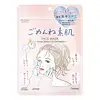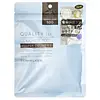What's inside
What's inside
 Key Ingredients
Key Ingredients

 Benefits
Benefits

 Concerns
Concerns

No concerns
 Ingredients Side-by-side
Ingredients Side-by-side

Water
Skin ConditioningButylene Glycol
HumectantDipropylene Glycol
HumectantPPG-10 Methyl Glucose Ether
Skin ConditioningGlycerin
HumectantPrunus Mume Fruit Extract
HumectantPunica Granatum Extract
AstringentTremella Fuciformis Extract
HumectantSchinus Molle Leaf Extract
Skin ConditioningSodium Hyaluronate
HumectantDisodium EDTA
PEG-8
HumectantAcrylates/C10-30 Alkyl Acrylate Crosspolymer
Emulsion StabilisingPEG-50 Hydrogenated Castor Oil Isostearate
EmulsifyingCarbomer
Emulsion StabilisingDiglycerin
HumectantTriethylhexanoin
MaskingSodium Hydroxide
BufferingC14-15 Dialkyl Carbonate
EmollientPhenoxyethanol
PreservativeWater, Butylene Glycol, Dipropylene Glycol, PPG-10 Methyl Glucose Ether, Glycerin, Prunus Mume Fruit Extract, Punica Granatum Extract, Tremella Fuciformis Extract, Schinus Molle Leaf Extract, Sodium Hyaluronate, Disodium EDTA, PEG-8, Acrylates/C10-30 Alkyl Acrylate Crosspolymer, PEG-50 Hydrogenated Castor Oil Isostearate, Carbomer, Diglycerin, Triethylhexanoin, Sodium Hydroxide, C14-15 Dialkyl Carbonate, Phenoxyethanol
Water
Skin ConditioningDipropylene Glycol
HumectantGlycerin
HumectantCerebrosides
EmollientNiacinamide
SmoothingAscorbic Acid
AntioxidantTrisodium Ascorbyl Palmitate Phosphate
AntioxidantMagnesium Ascorbyl Phosphate
AntioxidantAscorbyl Tetraisopalmitate
AntioxidantDipotassium Glycyrrhizate
HumectantButylene Glycol
HumectantTripropylene Glycol
AntioxidantHydrogenated Lecithin
EmulsifyingGlycine Soja Sterols
EmollientCeramide NP
Skin ConditioningCeramide AP
Skin ConditioningCeramide EOP
Skin ConditioningPhellodendron Amurense Bark Extract
Skin ConditioningPEG-60 Hydrogenated Castor Oil
EmulsifyingXanthan Gum
EmulsifyingEthylhexylglycerin
Skin ConditioningPotassium Hydroxide
BufferingCitric Acid
BufferingSodium Citrate
BufferingEtidronic Acid
Lavandula Angustifolia Oil
MaskingCitrus Limon Peel Oil
MaskingCitrus Aurantifolia Oil
CleansingLemongrass Oil
Juniperus Mexicana Oil
MaskingRosmarinus Officinalis Leaf Oil
MaskingPhytosphingosine
Skin ConditioningCholesterol
EmollientSodium Lauroyl Lactylate
EmulsifyingCarbomer
Emulsion StabilisingWater, Dipropylene Glycol, Glycerin, Cerebrosides, Niacinamide, Ascorbic Acid, Trisodium Ascorbyl Palmitate Phosphate, Magnesium Ascorbyl Phosphate, Ascorbyl Tetraisopalmitate, Dipotassium Glycyrrhizate, Butylene Glycol, Tripropylene Glycol, Hydrogenated Lecithin, Glycine Soja Sterols, Ceramide NP, Ceramide AP, Ceramide EOP, Phellodendron Amurense Bark Extract, PEG-60 Hydrogenated Castor Oil, Xanthan Gum, Ethylhexylglycerin, Potassium Hydroxide, Citric Acid, Sodium Citrate, Etidronic Acid, Lavandula Angustifolia Oil, Citrus Limon Peel Oil, Citrus Aurantifolia Oil, Lemongrass Oil, Juniperus Mexicana Oil, Rosmarinus Officinalis Leaf Oil, Phytosphingosine, Cholesterol, Sodium Lauroyl Lactylate, Carbomer
 Reviews
Reviews

Ingredients Explained
These ingredients are found in both products.
Ingredients higher up in an ingredient list are typically present in a larger amount.
Butylene Glycol (or BG) is used within cosmetic products for a few different reasons:
Overall, Butylene Glycol is a safe and well-rounded ingredient that works well with other ingredients.
Though this ingredient works well with most skin types, some people with sensitive skin may experience a reaction such as allergic rashes, closed comedones, or itchiness.
Learn more about Butylene GlycolCarbomer is a polymer of acrylic acid. Its main role is to create a gel consistency.
A high amount of carbomer can cause pilling or balling up of products. Don't worry, most products contain 1% or less of carbomer.
Dipropylene Glycol is a synthetically created humectant, stabilizer, and solvent.
This ingredient helps:
Dipropylene glycol is technically an alcohol, but it belongs to the glycol family (often considered part of the ‘good’ alcohols). This means it is hydrating and gentle on skin unlike drying solvent alcohols like denatured alcohol.
As a masking agent, Dipropylene Glycol can be used to cover the smell of other ingredients. However, it does not have a scent.
Studies show Dipropylene Glycol is considered safe to use in skincare.
Learn more about Dipropylene GlycolGlycerin is already naturally found in your skin. It helps moisturize and protect your skin.
A study from 2016 found glycerin to be more effective as a humectant than AHAs and hyaluronic acid.
As a humectant, it helps the skin stay hydrated by pulling moisture to your skin. The low molecular weight of glycerin allows it to pull moisture into the deeper layers of your skin.
Hydrated skin improves your skin barrier; Your skin barrier helps protect against irritants and bacteria.
Glycerin has also been found to have antimicrobial and antiviral properties. Due to these properties, glycerin is often used in wound and burn treatments.
In cosmetics, glycerin is usually derived from plants such as soybean or palm. However, it can also be sourced from animals, such as tallow or animal fat.
This ingredient is organic, colorless, odorless, and non-toxic.
Glycerin is the name for this ingredient in American English. British English uses Glycerol/Glycerine.
Learn more about GlycerinWater. It's the most common cosmetic ingredient of all. You'll usually see it at the top of ingredient lists, meaning that it makes up the largest part of the product.
So why is it so popular? Water most often acts as a solvent - this means that it helps dissolve other ingredients into the formulation.
You'll also recognize water as that liquid we all need to stay alive. If you see this, drink a glass of water. Stay hydrated!
Learn more about Water